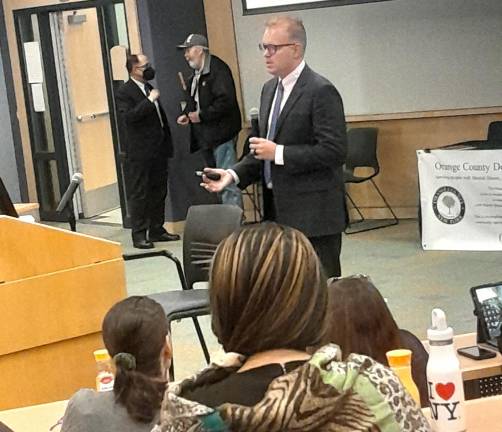Orange County educates residents on fentanyl risks, resources
Orange County. The county broke down its prevalence as well as signs of opioid use disorder.

In an effort to educate Orange County residents on the continued threat posed by fentanyl abuse, the county government recently hosted an enlightening information session free and open to the public at SUNY Orange’s Rowley Center for Science and Engineering. This fentanyl awareness presentation was also recorded live on Facebook.
Guest speakers Dr. Joshua Lynch, chief medical officer at NY Matters, and Dr. Matisyahu Shulman, a clinician-scientist at Columbia University, both educated people on research and treatments surrounding the topic of fentanyl, and opioids in general.
“We know that in Orange County, just almost 80% of the fentanyl supply has cocaine in it,” said Lynch. “Many of those patients did not know that there were opioids in there.”
According to the NYs Health Dept. Orange County had 104 fentanyl-related opioid deaths in 2022, which was actually slightly down from the previous year’s total of 125.
The Centers for Disease Control and Prevention (CDC) defines fentanyl as “a potent synthetic opioid drug approved by the Food and Drug Administration for use as an analgesic (pain relief) and anesthetic. It is approximately 100 times more potent than morphine and 50 times more potent than heroin as an analgesic.” Fentanyl can also be manufactured for illegal, non-medical use. In addition to cocaine, it has been found in methamphetamines, heroin, and even counterfeit pills. The CDC says “most recent cases of fentanyl-related overdose are linked to illegally made fentanyl.”
Lynch mentioned the 11 symptoms consistent with the clinical definition of Opioid Use Disorder (OUD), which is considered to be different than standard addiction. Symptoms include using larger amounts of opioid, and for longer durations than when initially described, an inability to cut back, more time spent getting/using opioids, and cravings.
He stressed the importance of diagnosing people with OUD so they can access specific medications that help to treat it. This includes using any of the three FDA-approved Medications for Opioid Use Disorder (MOUD), which are methadone, buprenorphine (suboxone), and naltrexone (vivitrol). This is also known as Medication Assisted Treatment (MAT). These medications can all, in their own way, lower the risk of a relapse or overdose, according to Lynch.
A personal struggle
Zack, a resident of Orange County who is recovering from previous opiate substance abuse, was in attendance. On the HEALing Communities Study YouTube channel, he spoke about his recovery journey with MOUD.
“About six years ago, I was working at a gym doing a lift and I injured my back,” said Zack. “I went to a doctor and was able to get a prescription for an opiate, which I almost immediately started misusing. In short time, I went from someone who had a job, a relationship, a family, happiness and peace, to none of that being there. A complete unravel, and it was almost night and day.”
He continued, “I understand where the [skeptics of MOUD] are coming from. It is usually a point of concern. They do not want their loved one trading one medication for the other. What I can tell them is that it actually bridges the gap between substance use and life. If I can depend on the fact that I am safe with this medication, then I can go ahead and live my life.”
Lynch believes MAT should be combined with counseling and peer support to ensure a higher likelihood of recovery. “The way I think about this is the medication typically does the heavy lifting. The other support services help the patient kind of rebuild. So, the way I look at it is you really need a combination of both. It is really tough to do just one.”
Zack has been on an MOUD for five years now and calls them “an anchor which sustains him.”
“Because I have this medication, it enables me to think about everything else... When I wake up in the morning, I feel safe, I have tremendously good people in my life, I have tons of support, I have a challenging career, I have hope, I have vehicles, I have a home, I have many things I can contribute to the constancy of MOUD,” said Zack.
To find resources for OUD in Orange County, check out healtogetherny.org/orange.
For more information, or to access the presentation materials, visit fb.watch/nz-FQHw8yx.